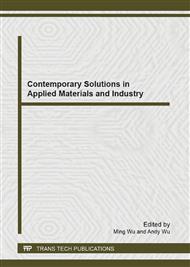p.59
p.65
p.70
p.75
p.81
p.86
p.94
p.100
p.105
Liquid-Phase Method Preparation of Water-Soluble ZnS:Cu2+ Nanoparticles and Luminous Performance Research
Abstract:
Series samples ZnS: Cu2+ have been prepared by Liquid-phase method and the final productivity has a great improvement compared with traditional method. Different concentration thioglycolic acid (TGA) modified combining nanoparticle makes water soluble ability better. When precipitating agent water and ethanol volume ratio is 3:1, sample production rate is the highest. Under XRD theoretical calculation ,the size of the series of samples are about 16nm , and the sample size is 18 nm while using Laser Particle Size Analyzers(Rise - 2208)measured. Series sample shows strong absorption under 200 nm to 340 nm range. Through absorption spectrum calculating the forbidden band width is about 3.58 eV. Under 210 nm of excitation, the emission spectrum shows that the strongest peak locates in 425 nm which belongs to Cu2 + ions’ t2 transition.
Info:
Periodical:
Pages:
81-85
Citation:
Online since:
April 2013
Authors:
Keywords:
Price:
Сopyright:
© 2013 Trans Tech Publications Ltd. All Rights Reserved
Share:
Citation:


